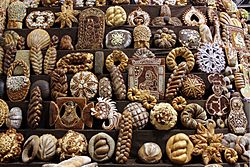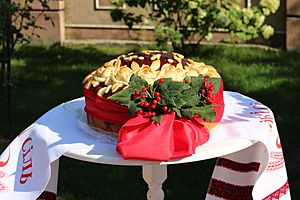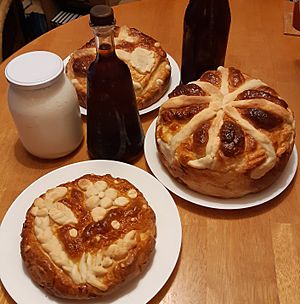Korovai facts for kids

Russian karavais at the Berlin International Green Week
|
|
| Alternative names | Korovai |
|---|---|
| Type | Bread |
| Place of origin | Russia |
| Region or state | Eastern Europe |
| Main ingredients | Wheat flour |

The korovai (Ukrainian: коровай, Russian: коровай), also called karavai (modern Russian: каравай, Belarusian: каравай) or kravai (Bulgarian: кравай), is a special traditional bread. It comes from countries in Eastern Europe like Bulgaria, Ukraine, and Russia.
This bread is most often used at weddings, where it has a very important symbolic meaning. It is still a big part of wedding traditions in Belarus, Russia, and Ukraine. People from these countries who live in other parts of the world also use it. The custom of using korovai goes back to ancient times in Rus', where it was used for welcoming guests and during holidays. A similar bread is also made in some parts of eastern Poland.
A round korovai is often used in a special welcoming ceremony called the "bread-and-salt" ceremony. This is a way to show hospitality and good wishes.
What is Korovai?
The korovai is a large, round, braided bread. It is traditionally baked using wheat flour. It is often decorated with many symbolic shapes and figures. These can include suns, moons, birds, animals, and even pine cones. People also use wheat stalks, herbs, nuts, flowers, and fruit to make the korovai look beautiful.
The design of the bread is not always the same. It can look different depending on the region where it is made. However, the colors red, gold, and silver are often used in its decorations.
The History and Look of Korovai
This special bread has very old roots. Its origins come from ancient beliefs that grain had magical powers.
The korovai was traditionally prepared at the bride's home. Women who made the bread would sing traditional songs while they worked. These women were called the korovainytsi. Usually, an odd number of women, often seven, were invited to help bake the bread.
The decorations on the korovai each have a special meaning. For example, two birds made from dough often stand for the marrying couple. Other birds can represent their family and friends. The whole design is usually surrounded by a wreath of periwinkle. This plant is a symbol of love and purity. Before the korovai is placed in the oven, it receives special blessings.
The bride and groom were given the korovai as a blessing before their wedding ceremony. Sharing the korovai with all the wedding guests was seen as a very important part of the wedding. In the past, if a full wedding ceremony was not possible, the blessing and sharing of this bread was sometimes enough for the community to consider the couple married.
Sharing the Korovai
The top part of the korovai often represents the Moon. This part is usually divided in half and given to the newly married couple. The next slice goes to the bride's parents, and so on.
In eastern Ukraine, the mother might receive a pair of shoes made from dough. The father might get an owl, which is one of the decorations from the korovai.
The very bottom section of the korovai is called the pidoshva. This part can be shared with the guests and the band. It is seen as a symbol of good luck and future success.
See also
 In Spanish: Korovai para niños
In Spanish: Korovai para niños


